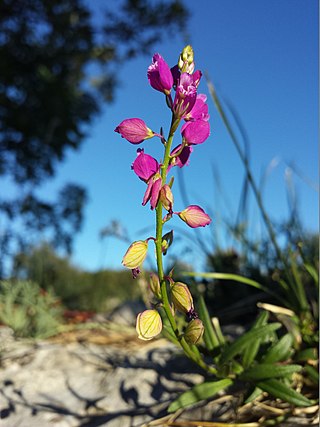
The Polygalaceae or the milkwort family are made up of flowering plants in the order Fabales. They have a near-cosmopolitan range, with about 27 genera and ca. 900 known species of herbs, shrubs and trees. Over half of the species are in one genus, Polygala, the milkworts.

Polygala is a large genus of flowering plants belonging to the family Polygalaceae. They are commonly known as milkworts or snakeroots. The genus is distributed widely throughout much of the world in temperate zones and the tropics. The genus name Polygala comes from the ancient Greek "much milk", as the plant was thought to increase milk yields in cattle.

Polygala vulgaris, known as the common milkwort, is a herbaceous perennial plant of the genus Polygala in the family Polygalaceae.

Polygala myrtifolia, the myrtle-leaf milkwort, is an evergreen 2–4 m tall South African shrub or small tree found along the southern and south-eastern coasts, from near Clanwilliam in the Western Cape to KwaZulu-Natal. It is a fast-growing pioneer plant, a typical fynbos component, and may be found on dunes, rocky places, along forest margins, beside streams, and in open grassland. It belongs to the milkwort family of Polygalaceae.

Polygala comosa is a species of flowering plant in the family Polygalaceae. It is endemic to most of Europe.
Polygala crassitesta is a species of flowering plant in the family Polygalaceae. It is endemic to Western Australia, the Northern Territory and Queensland.
Senega crenata is a species of flowering plant in the family Polygalaceae. It occurs in Alabama.

Senega cymosa, the tall pinebarren milkwort, is a species of flowering plant in the family Polygalaceae. It is endemic to the United States.

Polygala fruticosa is a species of flowering plant in the milkwort family (Polygalaceae). It is native to Eswatini and Kwazulu-Natal and the Cape Provinces in South Africa. It was first described by Peter Jonas Bergius in 1767. According to the Red List of South African Plants, it is of least ecological concern.
Senega hookeri is a species of flowering plant in the milkwort family (Polygalaceae). It is endemic to Alabama.

Polygala hottentotta is a species of flowering plant in the milkwort family (Polygalaceae). It is native to South Africa, Namibia, Lesotho, Mozambique, Eswatini, and Zimbabwe.

Polygala japonica is a species of flowering plant in the milkwort family (Polygalaceae). It is native to Northeast, East and Southeastern Asia, as well as eastern Australia. It is a wiry and decumbent dwarf shrub with a height between 10 and 25 centimetres. Its stems have tiny curled hairs. Its leaves are 5 to 20 millimetres long and 3 to 10 millimetres wide. Its flowers are purple to mauve and 5 to 6 millimetres long. It flowers between October and December.

Senega longicaulis, the longstem milkwort, is a species of flowering plant in the milkwort family (Polygalaceae). It is an annual dicot that is native to the Americas.

Senega mariana, the Maryland milkwort, is a species of flowering plant in the milkwort family (Polygalaceae). It is endemic to the southern and eastern United States. It is an annual with a height between 4 and 16 inches and it flowers between June and October.

Polygala nicaeensis is a species of flowering plant in the milkwort family (Polygalaceae). It is native to France and Italy.

Senega paniculata is a species of flowering plant in the milkwort family (Polygalaceae). It is native to grasslands with altitudes between 350 and 1,700 metres. It is native to Central and South America and has been introduced to East Africa, South Asia, and Southeast Asia. It is an annual herb which has a height between 15 and 50 centimetres It is used as a medicine against snake bites and blenorrhagias. The flowers of the plant have been described as pink or white.

Polygala rehmannii is a species of flowering plant in the milkwort family (Polygalaceae). It is endemic to areas with an altitude below 1,160 metres (3,810 ft) in Southern Africa. It was first described by Robert Chodat in 1893.

Polygala tatarinowii is a species of flowering plant in the milkwort family (Polygalaceae). It is native to China, Japan, Korea, Russia, Myanmar, the Philippines, Taiwan, and Vietnam. It is a herb that grows up to 15 cm (5.9 in) tall.

Polygala umbellata is a species of flowering plant in the milkwort family (Polygalaceae). It is endemic to the Cape Provinces of South Africa.
Polygala irregularis is a species of flowering plant in the family Polygalaceae. It is a perennial herb with a height up to 60 centimetres (24 in), though the average ranges from 17 to 34 centimetres. It produces lilac to reddish-brown flowers. It is native to grasslands and sandy areas of Northern Africa, the Middle East, and South Asia with altitudes below 500 metres (1,600 ft).














